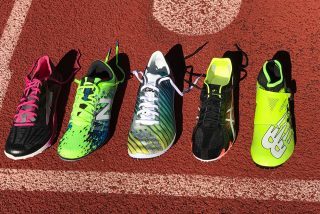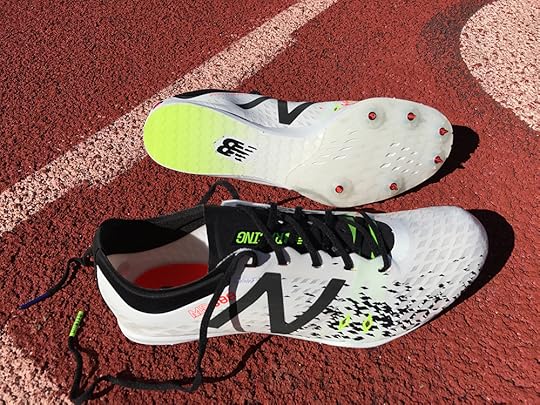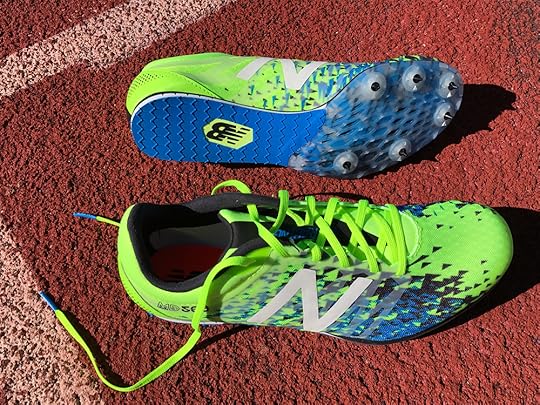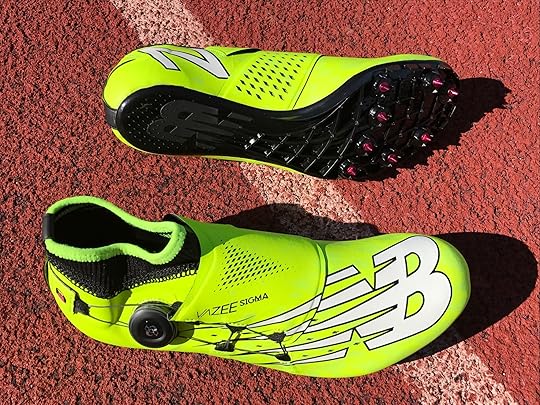A Rundown Of The Year’s Speediest Track Spikes


Today’s spikes are sexier than ever. Uppers are ultra-light and form-fitting, and soles are sculpted from high-tech materials to produce smooth, speedy toe-offs. New companies like Hoka One One, Altra and Under Armour have entered the field, driving innovation in cushioning, fit and quality, while established players keep raising the bar for lightweight comfort and ride. Never has there been more choices and more excellence waiting for you to lace up and go tear up the track.
RELATED: 2017 Running Gear Guide—Road Shoes
Middle-Distance/Distance Spikes
Brooks 3 ELMN8, $120
Weight: 4.1 oz. (unisex)
A carbon fiber torsion bar lies at the heart of the all-new third version of the ELMN8, Brooks’ top-of-the-line middle-distance spike. Designed with the help of elite athletes like Nick Symmonds and Katie Mackey, the shoe has an aggressive, springy ride with minimal midsole cushion. Testers universally enjoyed the fit of the mesh upper, reporting that while it felt ultra-light, it held comfortably and securely heel-to-toe. Powerful, top-level runners appreciated the snappy turnover while others found the dramatic toe spring and the rigidity of the plate too much for their stride.

Altra Golden Spike, $90
Weight: 5.3 oz. (unisex)
It’s not a surprise that Altra’s first and only spike is unique. Not only does it have 15mm of cushioning heel-to-toe, but the five spike pins fit into the rubber outsole with no rigid plate to hinder flexibility. Most importantly, the Golden Spike is foot shaped with plenty of room for a forefoot splay. Altra co-founder Golden Harper believes most spikes are “human torture devices” that don’t allow the foot to perform naturally. “While making shoes super tight may not kill performance too much in shorter races,” Harper said. “I believe it definitely hurts performance and increases injury risk on longer races.” Testers found the shoes comfortable but a bit squishy feeling—better for races of 3200m or longer.
Brooks The Wire 4, $120
Weight: 3.8 oz. (unisex)
Weighing in just under 4 ounces, The Wire 4 provides a ride more akin to a racing flat than what one usually expects in a spike. A full-length midsole provides cushioned landings while a flexible spike plate and substantial toe-spring allow for a rolling stride. Testers unanimously lauded the cushioning and ride. “I really liked how these shoes rolled,” said distance runner Will Kuene of Imperial, Neb. “It felt like barefoot running.” The upper wrapped feet snuggly, too snuggly at the toes for several testers—you may need a half size larger than normal.

Hoka One One Speed EVO R, $130
Weights: 4.1 oz. (men’s), 3.6 oz. (women’s)
Hoka’s second generation of spike refines the concepts they presented in their debut. Most uniquely, the spike plate and pin locations are not symmetrical on the left and right feet—both are tuned to turn left, as racers inevitably do on the track. Designed for milers like Leo Manzano and longer races, the Speed EVO R continues the company’s emphasis on protection with twice as much cushioning underfoot than most spikes. The foam underfoot also wraps up on the sides, creating a foot-centering “bucket seat.” Testers universally praised the ride, which was light and fast even with the extra cushion. The layered-mesh upper is also a bit more rugged than many competitors and held the foot securely, although a few testers reported it pinched or slipped in some places.
New Balance LD5000V4, $120
Weights: 4.6 oz. (men’s), 4.0 oz. (women’s)
New Balance’s pinnacle distance spike won rave reviews from our testers for its quick, smooth turnover that seemed to match and enhance their strides. Credit that to the thin, full-length Pebax plate that flexes and rebounds underfoot while gripping the track at every contact point with its small, sharp “shark’s teeth” that complement the four spike pins. A thin layer of New Balance’s light, responsive midsole foam provides just the right cushioning to feel fast enough for the mile but not beat testers up on longer races up to the 10,000m. This year’s upper has fewer layers welded to the airy mesh, making them feel too roomy in the toes for one tester, but all appreciated the snug, comfortable fit of the refined heel collar.
Puma evoSPEED Distance V5, $70
Weights: 5.5 oz. (men’s), 4.2 oz. (women’s)
Puma kept it simple building this entry-level spike that performs nicely. The relaxed, seamless upper and moderately-curved shape accommodate a variety of foot shapes, and the full-length EVA midsole cushions and supports regardless of your foot strike. The five-pin, horseshoe-shaped plate is both flexible and responsive. In all, the evoSPEED Distance V5 is a good value that can give runners a racing-flat-like option to transition into wearing a track spike.

New Balance MD800v5, $120
Weights: 4.5 oz. (men’s), 3.9 oz. (women’s)
Suited for any race from the 800m to the 5,000m, the MD800v5 won accolades for their comfortable fit. “They’re very breathable, and once you tighten them up and start running, it feels like you’re running without any shoes on,” said Danny Bunker of Bucksport, Maine. The FantomFit upper is slightly lighter and more flexible in this year’s version, with a reinforcing strap ensuring a secure hold across the crucial ball of the foot. With six spike pin and a fairly rigid forefoot plate, this spike can harness a sprinter’s power, but distance runners didn’t find it at all overbuilt.
Saucony Ballista, $110
Weights: 3.1 oz. (men’s), 2.8 oz. (women’s)
Saucony used concepts from their award-winning ISOFIT road-running uppers when designing the Ballista. Rather than using an out layer of adjustable fingers, however, the Ballista’s laces tie into a strap that runs up the eyelet row and connects to supportive overlays, allowing for flexibility as the upper wraps the foot. Testers, particularly female ones, raved about the close, conforming fit. Olympian Duane Solomon helped in the design of the all-new Ballista, and those who run with his up-on-your-toes style most appreciated the aggressive, curved spike plate.

ASICS Gunlap, $100
Weight: 4.9 oz. (unisex)
Testers praised the forgiving fit of the upper and the underfoot flexibility of Asics’ lightest distance spike, designed for races from 800m to 3200m. Breathable mesh, generously reinforced with welded overlays, creates the comfortable fit while allowing heat and moisture to vent. The flexibility stems from a thin, “decoupled” Pebax spike plate that holds three spike pins on the big toe side and two along the outside. The only complaints came from two testers who felt the location of the spikes didn’t quite fall right and somewhat compromised their stride—reinforcing that all spikes should be tried before purchasing.
Saucony Endorphin, $110
Weights: 2.8 oz. (men’s), 2.5 oz. (women’s)
The lightest spike on the market, there’s not much to the Endorphin. The ride is close to the ground, with little support from the mesh upper, minimal cushioning and a small forefoot plate sliced with flex grooves. Testers who could handle feeling everything underfoot found the shoes felt fast and “kept you on your toes,” while others who needed more control and cushion found them “clunky.” The latter would be more comfortable in Saucony’s Vendetta ($65), which weighs twice as much and has the approachable, forgiving fit of their perennially-popular Kilkenny cross-country spike.
Under Armour Speedform Miler Pro, $120
Weight: 3.7 oz. (unisex)
For Under Armour’s first foray into track spikes they created an elite-level distance spike that draws on their apparel expertise. Like a high-end jacket, the pieces of the burrito-wrap upper are welded end-to-end and the welds covered with thin tape, create a smooth, seamless fit all the way around the foot. Underneath, the six-spike Pebax plate extends a tongue back into the midsole to produce push-off torque. The fit is narrow and the ride is aggressive. “It’s not for the faint of heart,” says creative designer Justin Howe. Testers concurred, reporting that they pinched the toes some, but rolled nicely and “felt very fast.”

New Balance MD500v5, $70
Weights: 5.2 oz. (men’s), 4.5 oz. (women’s)
Affordable and versatile is the goal for New Balance’s entry-level spike, and it delivers with a ride surprisingly similar to their MD800. Both have a similar spike plate, but the MD500v5 has less of a midsole and a more padded upper that provides a forgiving but not quite as precise fit. That upper was refined in the v5, making it lighter and with a more open, flexible toe box. All in all, the MD500v5 would be a great choice for a young athlete experimenting with events, and should even be rugged enough to pass down to a younger sibling.
RELATED: Get A Sneak Peek At 7 Special-Edition Boston Marathon Shoes
Sprint Spikes
Brooks 2QW-K, $110
Weight: 5.7 oz. (unisex)
The 2QW-K is all about torque, with a full-length, semi-rigid plate that wraps up around the sides of the midfoot and heel and translates the force from your foot into the eight forefoot spike pins. The synthetic leather upper is reinforced with structured overlays that lock your foot in place. Testers found the toe box tight and the transition up to the spikes abrupt, so you need to be ready to stay high on your toes if you’re going to wear these shoes, best suited for the pure sprints.

New Balance Vazee Sigma (SD200), $150
Weights: 6.2 oz. (men’s), 5.6 oz. (women’s)
The new Vazee Sigma uses a boa lacing system connected to a wrap that snugs the arch and heel to lock your foot down onto the eight-pin, rigid spike plate below, eliminating any motion. Testers appreciated the fit, which starts out generous and snugs down comfortably in the mid-foot while leaving enough room for normal toe movement. They also found the booty ankle collar a nice touch. The rigid, full-length plate doesn’t have quite as much toe spring as some others, which complemented powerful testers’ strides.
Under Armour Speedform Sprint Pro, $120
Weight: 6.9 oz. (unisex)
Under Armour’s first sprint spike takes full advantage of the company’s “apparel for feet” philosophy. Three-dimensional molding technology, such as used to make sports bras, creates a shaped heel that cradles underfoot and snugs around the ankle without limiting movement and power. The heel is welded seamlessly to a soft, stretchy synthetic upper, deemed the most comfortable among sprint spikes in this review. Underfoot, the full-length eight-pin plate has both a strong toe spring and some flexibility, making the spike suitable for many runners and races up to the 400m.
Saucony Showdown 4, $110
Weights: 5.2 oz. (men’s), 4.5 oz. (women’s)
Saucony’s ISOFIT lacing was first developed for the Showdown, and it has reached its pinnacle expression here. The laces tie into eight flexible fingers that wrap around an inner booty and through the outer upper, snugging the vamp to the exact shape of your foot. The heel is cupped and holds your ankle like a soccer cleat. Once laced down, your foot isn’t going anywhere, and all of your force is transferred to the full-length, high-rebound 10-spike plate. Testers heaped praise on the security and comfort of the fit and the superior grip.
Saucony Spitfire 4, $65
Weights: 5.4 oz. (men’s), 4.7 oz. (women’s)
An entry-level spike aimed at first-time sprinters, the Spitfire has premium DNA in an affordable and forgiving package. The fit is roomier and the three-quarter length plate is more flexible than their top-end Showdown, allowing for a wide range of abilities and events, from the long jump to the 400m. Testers found the spike held their foot tightly enough that it didn’t move around, and appreciated the comfort of the padded upper.
RELATED: 2017 Running Gear Guide—Trail Shoes
The post A Rundown Of The Year’s Speediest Track Spikes appeared first on Competitor.com.
Ryan Hall's Blog
- Ryan Hall's profile
- 21 followers



